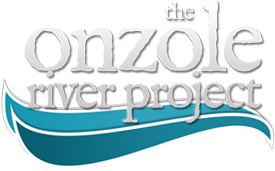The Onzole River Project has an intern! Carlos Vieira, a recent grad in Journalism and Political Science from Ottawa’s Carleton University, will be here for 6 months working in the communities along the Onzole River, following God’s call and seeing where He leads. This story was originally published on his blog‚ earlier this month.
*****
The air in the room is thick and heavy. Despite the open windows and the dark night sky there is no reprieve from the unrelenting humidity. But the sweat glistening on the brows and soaking the clothes of those gathered could never dampen their mood. As the last of the expected enters the small open room everyone takes their place, standing at the ready.
The frontman taps his foot on the ground, his body swaying to the imaginary beat as he raises his clarinet to his mouth. He signals the rest and all at once the beat jumps to life, overflowing from within the four concrete walls into the streets beyond.
The beat of the percussion is loud and frantic, keeping a seemingly unsustainable rhythm. The frontman’s clarinet pierces through, laying down the flowing melody for the voices to follow. There’s the old man on the bass, his experienced fingers sliding over the strings and the sweet sound of the bamboo marimba, holding everything together.
As the beautiful music fills my ears and my own feet start to trace the beat, my eyes are transfixed, unable to turn away from the dancers before me. Their quick feet move in perfect unison, every rapid step timed perfectly to the beat of the drums, leading their hips through motions so fluid most could only dream of keeping up. Their long skirts filled with vibrant colors sway back and forth, opening up like a flower in bloom then quickly closing up as the dancer takes another step. The colors hang from their hips like a tapestry, making each dancer a mesmerizing moving piece of beautiful art.
This is Marimba, the cultural heart and soul of Ecuador’s Afro community, and if tonight’s practice reveals anything it’s that the heartbeat remains strong.
A cultural inheritance from their African ancestors, Marimba has been a hallmark of Afro-Ecuadorian communities for centuries, keeping the bonds of community tight during the days of slavery and the difficult days of isolation in the country’s dense jungles. As the Afro-Ecuadorian community has slowly migrated into Ecuador’s towns and cities, Marimba remains an important way for them to engage and celebrate their African heritage with their distinct Latin flair.
Groups like the one practicing this night are common, especially in the predominantly Afro city of Esmeraldas, located along the Pacific on Ecuador’s North-West coast. As they gather and the intensity of the song and dance begins to grow the smiles on the faces grow as well. Songs about picking cocoa and making delicious chocolate black as their skin celebrate the very trait that many have said is what makes them inferior. There is no sense of that here tonight, though. There is only pride. Pride in their art-form, pride in their ancestors and most importantly pride in themselves.
With every beat of the drum and shuffle of the feet there is a connection made, between the individuals in the room, yes, but it runs deeper than that. The connection is with a collective history that has come before. As the sweat glistens over the bodies of the drummers, the dancers and the other musicians, there is a knowledge and understanding of those who have come before and whose sweat glistened, just as it does now, as a similar beat played. It’s a glimpse into the beauty of shared experiences and their uncanny ability to bridge gaps, both of time and place.
And this is what Marimba, as with any art, is all about: Generations teaching generations the traditions of a shared culture, passing down not only the swivel of the hips and rhythmic beating of the percussion but of the pride and joy that comes with it. That when a girl in today’s Esmeraldas dons her flowing skirt and takes the first choreographed steps, she knows she is not alone, she is part of a deep and wondrous collective that will continue on, singing and dancing long into the night.

